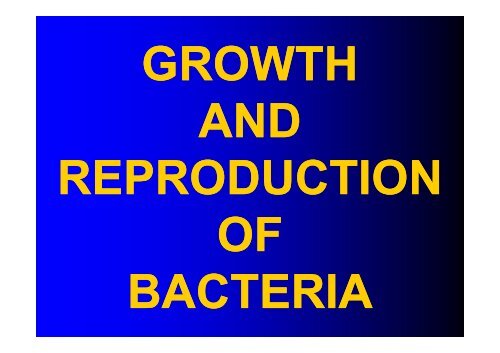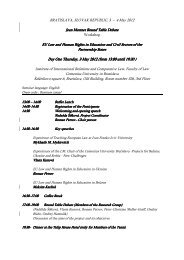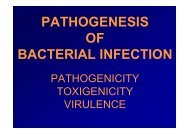GROWTH AND REPRODUCTION OF BACTERIA
GROWTH AND REPRODUCTION OF BACTERIA
GROWTH AND REPRODUCTION OF BACTERIA
You also want an ePaper? Increase the reach of your titles
YUMPU automatically turns print PDFs into web optimized ePapers that Google loves.
<strong>GROWTH</strong><strong>AND</strong><strong>REPRODUCTION</strong><strong>OF</strong><strong>BACTERIA</strong>
ReproductionofmicroorganismsBacteria multiply by transverse division.Yeasts multiply by budding.Actinomycetes by fragmentation offilaments.
Bacterial replication is a coordinatedprocess in which two equivalent daugthercells are produced.For growth to occur, there must besufficient metabolites to support thesynthesis of the bacterial components andespecially the nucleotides for DNAsynthesis.
The production of two daughter bacteriarequires the growth and extension of the cellwall components followed by the productionof a septum (cross wall) to divide the daughterbacteria into two cells. Septum formation is initiated at the cellmembrane. The septum grows from oppositesides toward the center of the cell, causingcleavage of the daughter cells.
Chromosome replication is initiated at themembrane, and each daughter chromosome isanchored to a different portion of membrane. In some bacterial cells, the DNA associates withmesosomes. As the bacterial membrane grows, the daughterchromosomes are pulled apart. Commencement of chromosome replication alsoinitiates the process of cell division, which can bevisualized by the start of septum formation betweenthe two daughter cells.
Bacterial cell division
Generative (ordoubling) time It is the time, covering the beginning of division ofthe mother cell up to the formation of two new cells. The average generative time is about 20 – 30minutes in a majority of medically importantbacteria. They are some exceptions among pathogenicbacteria:– Mycobacterium tuberculosis has the generative timeabout 18 hours,– Mycobacterium leprae has even much longer generativetime than other species (10 – 20 days).
The length of the generative time is ina direct dependance on the length ofan incubation or prodromed period ofinfections.In a certain extent, the same rule isapplied for antibiotic therapy.
Population dynamics When bacteria are added to a medium, they require timeto adept to the new environment before they begindividing. This hiatus is known as lag phase of growth. The bacteria will grow and divide at a doubling timecharacteristic of the strains and determined by theconditions during the exponencial phase. During thisphase, the number of bacteria will increase to 2 n , inwhich n is the number of generations. The cultures runs out of metabolites, or a toxicsubstances builds up in the medium. The bacteria thenstop growing and enter the stationary phase.
The multiplication of bacteria in a closed systemis limited by exhaustion of nutrients and increaseof hydrogen ions and toxic metabolites Growth cycle in a closed system:– After inoculation of a fresh medium of the closedsystem, bacteria grow and multiply in successivephases: lag phase (or phase of adaptation) phase of acceleration (or phase of physiological youth) phase of exponential growth stationary growth phase phase of decline
Phases of bacterial growthBacterial numberStationary phaseLag phaseExponencial phasedeclinetime
The majority of bacterial and fungal species ofmedical importance grow in artificial media in thelaboratory. Some bacteria cannot be cultivated on solid nutrientmedia surfaces and can only be grown in cellcultures (e.g. chlamydia, chlamydophila, rickettsia). Some bacterial species cannot be grown at all exceptin experimental animals (e.g. Treponema pallidum). Viruses must be grown in cell or tissue cultures asthey are incapable of free-living existence. Some parasites (e.g. Trichomonas vaginalis) can becultivated in liquid media but it is easier to detectthem by microscopic examination (Giemsastaining).
There are some basic conditions forcultivation of bacteria: Optimum environmental moisture. It is possible tocultivate bacteria in liquid media or in solid media witha gelling agent (agar) binding about 90 % of water. Optimum temperature for cultivation of bacteria ofmedical importance is about 37 °C. Saprophyticbacteria are able to grow at lower temperatures. Optimum pH of culture media is usually 7.2-7.4.Lactobacillus sp. needs acid pH and Vibrio choleraealkaline pH reaction for the growth. Optimum constituents of bacteriological culturemedia. All culture media share a number of commonconstituents necessary to enable bacteria to grow invitro.
Optimum quantity of oxygen in cultivationenvironment Bacteria obtain energy either by oxidation or by fermentation,i.e. oxidation-reduction procedure without oxygen. Bacteria areclassified into four basic groups according to their relation toatmospheric oxygen:– Obligate aerobes – reproduce only in the presence of oxygen.– Facultative anaerobes – reproduce in both aerobic andanaerobic environments. Their complete enzymatic equipmentallows them to live and grow in the presence or absence ofoxygen.– Obligate anaerobes – grow only in the absence of free oxygen(i.e. unable to grow and reproduce in the presence of oxygen).Some species are so sensitive that they die if exposed to oxygen.– Anaerobic aerotolerant microbes do not need oxygen for theirgrowth and it is not fatal for them.– Some aerobic and anaerobic bacteria need 5-10 % CO 2 inthe environment.









